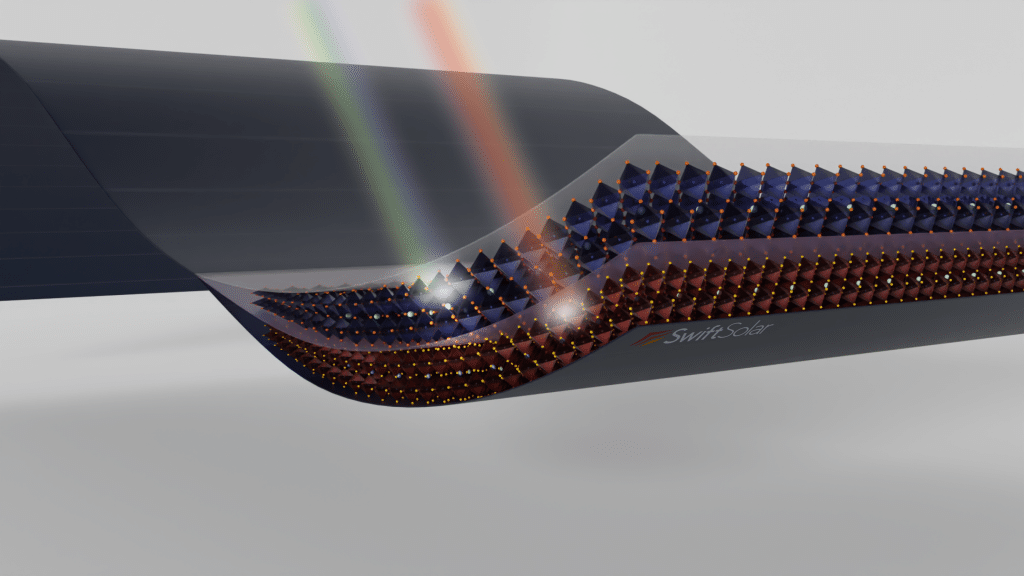SAN CARLOS, Calif., Dec. 15, 2020 /PRNewswire/ — Solar PV technology company Swift Solar announced today that it secured more than $8 million in Series Seed 2 funding, with an additional $1.5 million expected to close soon, for a total of $9.6 million. The round was led by GitLab CEO Sid Sijbrandij and cryptocurrency expert James Fickel. Other participants in the round include climate tech and deep tech investors Good Growth Capital, Safar Partners, Climate Capital, Jack Fuchs, and Sierra Peterson, crypto and finance professionals Jonathan Lin, Grant Hummer, and Ethereum creator Vitalik Buterin, and a diverse group of angel investors. The funding round will be used to expand R&D capabilities, develop prototypes, and grow the Swift Solar team.

Swift Solar’s perovskite tandem technology delivers abundant zero-carbon electricity for any application under the sun.
“Today’s industry leaders recognize that perovskite technology represents new possibilities for the future of solar,” said Co-Founder and CEO Joel Jean. “The Swift Solar team is working nonstop to make solar panels more affordable, more efficient, and easier to install. With this funding, we can move faster on our path toward powering tomorrow’s zero-emissions vehicles and power grids with high-performance solar.”
Swift Solar—recently recognized by a joint R&D 100 Award with the U.S. Department of Energy’s National Renewable Energy Laboratory (NREL)—has raised over $16 million in equity financing to date. The company is also supported by non-dilutive funding from the National Science Foundation, the U.S. Department of Energy, and the Office of Naval Research.
“We have to accelerate innovation to limit climate change,” said Sijbrandij. “Swift Solar’s cutting-edge solar technology is an important piece of the puzzle, and the Swift team is second to none. I’m proud to help accelerate their work so it can meet the urgency of the moment.”
“Swift Solar’s groundbreaking perovskite technology was created by incredible scientists who have deep expertise in how to make solar work better for cheaper,” said Fickel. “This is the company I trust to take solar power to the next level.”
A Deeper Look at Swift Solar’s Innovative Perovskite Technology
Swift Solar is working to develop a new solar PV technology—metal halide perovskites—that could fundamentally outperform today’s silicon and thin-film technologies. Within 10 years, perovskite tandems could be more efficient, more affordable, and more scalable than any PV product on the market.
Perovskite solar cells require less material than conventional technologies, and the raw materials are significantly more abundant and less costly. Manufacturing of perovskite PV modules involves simpler and higher-throughput manufacturing equipment and less energy than is needed for silicon PV manufacturing. Flexible perovskite solar panels can reach unparalleled power-to-weight ratios and can be rolled up like a tarp and laminated onto nearly any surface. And they enable multijunction, or tandem, cell structures that could reach power conversion efficiencies of over 40 percent, breaking through the ~30 percent limit of current technology and providing more watts per dollar spent on installation.
With this combination of higher efficiency, power density, and flexibility, Swift Solar’s perovskite PV technology could keep drones in the sky for months at a time, recharge electric vehicles, power homes, and provide supplemental and off-grid power in developing countries and disaster areas.
About Swift Solar
Swift Solar creates breakthrough solar products that deliver unparalleled performance and versatility. Swift Solar was founded in 2017 by global pioneers of perovskite photovoltaic technology with a shared vision for the future of solar. The Swift Solar team believes that solar energy has vast untapped potential to reduce inequity and protect planetary health in the face of global climate change. For more information, please visit www.swiftsolar.com. Follow Swift Solar on Twitter and LinkedIn and sign up for Swift’s mailing list to receive the latest company news.




About The Author: Joel Jean
Joel is the CEO and co-founder of Swift Solar, a US company building next-generation solar technology.
More posts by Joel Jean